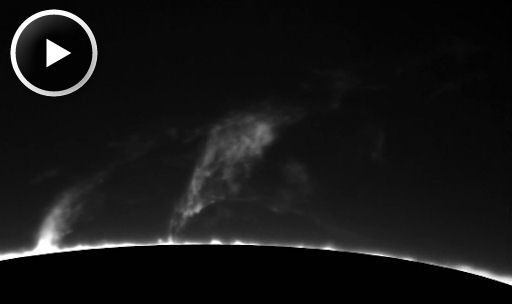Listen to radar echoes from satellites and meteors, live on listener-supported Space Weather Radio. | | |
QUIET SUN: Solar activity is low. NOAA forecasters say the chance of an M-class flare today is no more than 10%. An X-flare is even less likely: less than 1%. No strong flares are in the offing.
PLASMA RAIN: Despite the quiet, there has been something to see on the sun this weekend. Yesterday amateur astronomer Michael Buxton of Ocean Beach, CA, witnessed an episode of "plasma rain" on the sun's western limb. Click on the arrow to set the shower in motion:

The movie,which Buxton assembled from a series of 1 minute exposures taken over a 2 hour period on Sept. 15th, shows Moon-sized "droplets" of plasma swirling and falling along magnetic field lines from the sun's atmosphere to the sun's surface. That's how it rains on the sun.
This storm cloud, aka "prominence", has since rained out. The western limb is clear and sunny again.
NOT AURORAS: For the past week, solar wind has been buffeting Earth's magnetic field, turning skies around the Artic Circle beautiful shades of green. But not every green sky is caused by the aurora borealis. On Friday night, for example, pilot Brian Whittaker was flying 34,000 feet over the Atlantic Ocean when he witnessed verdant hues caused by a completely different phenomenon--airglow. Here is the picture he took from the cockpit window:

"A dark and moonless night away from all lights allowed a great view of this textured patch of airglow," says Whittaker. "The illumination was faint, but it could be seen especially in contrast to the dark ocean abyss below!"
Although airglow resembles the aurora borealis, its underlying physics is different. Airglow is caused by an assortment of chemical reactions in the upper atmosphere. During the day, ultraviolet radiation from the sun ionizes atoms and breaks apart molecules. At night, the atoms and molecules recombine, emitting photons as they return to normal. This process produces an aurora-like glow visible on very dark nights.
Because the Moon is new on Sept. 15th, tonight is a good night to spy this phenomenon. Get away from city lights, if you can, and take a look!
Realtime Space Weather Photo Gallery
Realtime Aurora Photo Gallery
Realtime Noctilucent Cloud Photo Gallery
[previous years: 2003, 2004, 2005, 2006, 2007, 2008, 2009, 2011]

